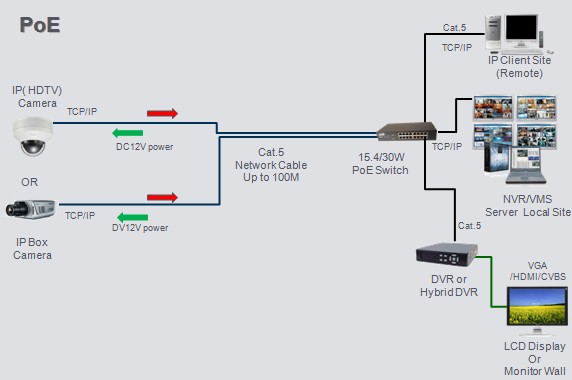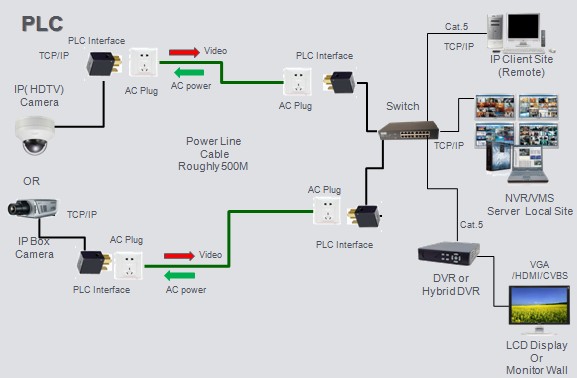There are several types of transmission, and in any network, a carefully designed transmission infrastructure will determine the performance of the security system. A prerequisite for robust and effective transmission is to know the difference between the types of transmission.
The advent of network cameras brought about convenience and integration capabilities to security systems, but also required more complex methods of wiring the separate devices into an integrated system. People most often talked about cameras and storage devices, while taking transmission for granted.
Transmission is crucial in a security system; it is the glue that physically connects the network devices in a security system. A well-designed transmission infrastructure can optimize a security system, and save on installation and operating costs. However, this is easier said than done and will most often test the experience of the system integrator or installer, as clear calculations at every stage of the design are crucial. Clear calculations ensure that the transmission is capable of coping with the operating environment, scalable to future expansion needs and fits end-users' budgets.
There are three common types of transmission available: power over Ethernet (PoE), Ethernet over Coax (EoC), and power line communication (PLC). 
Power over Ethernet
PoE has been dubbed as “perhaps the greatest invention” to hit the security camera market since the introduction of network cameras. Worldwide Ethernet switch (Layer 2/3) revenues reached US$5.7 billion in the fourth quarter of 2012, representing a growth of 7 percent sequentially and 0.5 percent year on year, according to International Data Corporation (IDC). Regionally, the Ethernet switch market was strongest in the APAC region, excluding Japan, with 15.5 percent year-on-year growth, followed by the Middle East and Africa with 13.8 percent, and Latin America with 12 percent.
“PoE is a technology of safely transferring electrical power, together with Ethernet data, to Ethernet/ network devices via Ethernet cables. This technology is mainly based on the standards IEEE802.3af and IEEE802.3at, which are derived by the Institute of Electrical and Electronics Engineers,” explained Calvin Wong, Sales Director of OT Systems.
PoE devices are categorized as power supply equipment (PSE) and powered devices (PD). PSEs supply power and include network switches, media converter, PoE injectors, etc. On the other hand, PDs receive power and include network cameras, wireless LAN access points, access control equipment, and VoIP, to name a few.
In PoE technology, the PD such as the camera is connected to a PoE switch via Ethernet cables. The IEEE standards define how PSEs and PDs work together. Although a standard cable has four twisted pairs, only two are used for the 10BASE-T and 100BASE-T data transmission. Power transmission can occur on either the “data pairs” or the “spare pair”, but not both.
The rise of network cameras is largely affected by the increasing ease-of- installation, which can be attributed to PoE technology. PoE eliminates the need to use localized power or install additional cable to power the devices, thereby saving on installation costs.
.jpg)
Ethernet Over Coax
EoC provides an attractive option for end users who would like to switch to network cameras or add network cameras to their existing surveillance system without overhauling the entire initial investment, because the network cameras can be integrated into existing coaxial cables. As the majority of analog cameras were installed using coaxial cables, end users can upgrade to network cameras without having to reinstall cables.
“EoC allows legacy coax to be redeployed as part of an upgrade/migration to PoE cameras and devices. This technology and transmission method saves on investment as newly installed cabling is not required, quickens installation time, and reduces facility disruption during the migration,” said Guy Apple, VP of Marketing and Sales at Network Video Technologies. In this sense, it allows migration from analog systems to network systems at the end-user's pace and budget. 
EoC transmission is adaptable to the length of the existing coaxial cable, which could be up to two kilometers. There are several methods of achieving EoC. “Security Link over Coaxial (SLOC), is designed for transmitting digital IP video together with composite video over a single coaxial cable, while very high bit-rate digital subscriber line (VDSL) is a technology for transmitting Ethernet signal over digital subscriber line. The line can be one twisted pair of copper wires or a coaxial cable,” said Wong.
VDSL2 is the second generation of VDSL, and uses frequencies of 30MHz to provide data rates of 100Mbps downstream and upstream, compared to VDSL that only supports 55Mbps downstream and 3Mbps upstream. The maximum available bit rate is achieved at a range of about 300 meters, after which, performance degrades.
Intersil's SLOC is a form of EoC transmission and can be integrated directly into the equipment. “SLOC overcomes the distance limitations of network cameras (up to 500 meters over RG59 cable), as well as enables the upgrading of existing solutions from standard definition analog video to megapixel network cameras using the existing coaxial cables,” said Joe Hanson, Senior Marketing and Business Development Manager of Video Security Products at Intersil.
Power Line Communication
PLC is a technology for carrying data over power lines and can be extended to coaxial cables as well, explained Wong. The technology provides a simple solution for distributing connectivity around the home, office, or building without the need to install any additional wires. PLC operates by adding a modulated carrier signal to the wiring system, and different types of PLC uses different frequency bands. Since the power distribution system was designed to transmit AC power at frequencies of 50 or 60 Hz, power wire circuits have only a limited ability to carry higher frequencies.
HomePlug is the technology that connects devices to each other through the power lines in a building. The HomePlug Alliance is a group of manufacturers and service providers that have agreed upon standards so that certified products connect PCs and other devices that use Ethernet, USB, and WiFi technologies to the power line via a bridge or adapter.
Using PLC interfaces, digital signals from network cameras are encoded and transmitted through existing power lines to the back end, where PLC interfaces connect to the Ethernet switches. The switches then transmit the data via Ethernet cables to DVRs, LCD or monitor displays, IP remote client site or NVR/VMS servers.
As expected, PLC transmission is only viable via existing PLC infrastructure, which dictates the transmission distance as well.
There is no one-size-fits-all transmission. The key is to know what the end-user's transmission needs are and select the best medium to meet those needs.